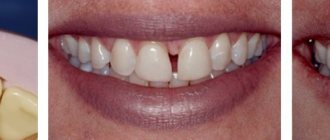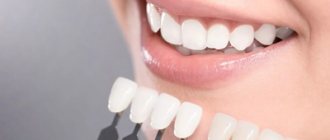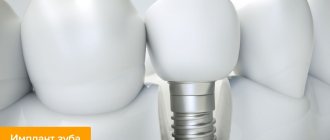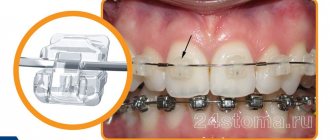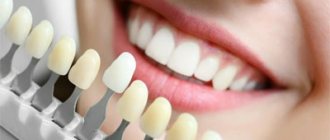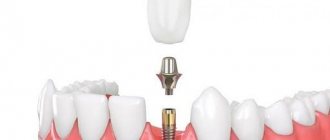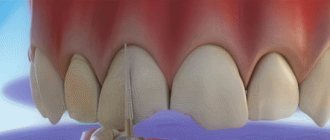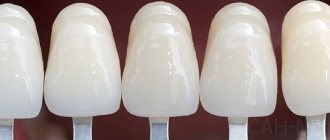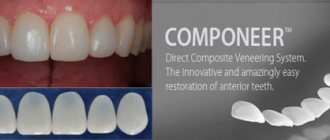Chief editor of the site:
Snitkovsky Arkady Alexandrovich
Chief physician of the professorial dentistry “22 Century”, dentist, orthopedic dentist
Author of the article:
Scientific team of dentistry “22 Century”
Dentists, candidates and doctors of medical sciences, professors
Types of veneers
Every year new technical developments appear in dentistry and existing ones are improved. How can a patient who does not have a specialized medical education understand what VENEERS are and why they need them? Veneer (adhesive lining, onlay) is a non-removable microprosthesis that covers the outer (vestibular) surface of the tooth and restores its anatomical shape and color. In this case, the preparation (“drilling”) of dental tissues is minimal or absent . Almost all clinics deal with this type of aesthetic restoration and offer several types of this design.
Historical reference
Composite materials are modified plastics with improved aesthetic, strength and handling properties. Their connection with tooth tissues is due to adhesion.
Adhesion (Latin adhesio - fusion, adhesion) is the phenomenon of adhesion between two surfaces brought into contact. Systems created on the basis of this phenomenon are widely used in dentistry.
Currently, there are seven generations of these systems , with the fourth to seventh being used in clinical practice. They differ from each other in adhesion strength, the relationship of the components (separately or in combinations) and indications for use.
The widespread use of veneers dates back to the 1980s.
Rules for hygienic care of veneers
If proper care is followed, veneers can serve their owner for up to 15 years. In order not to lose microprostheses before this period, experts advise:
- do not bite nuts or crack seeds;
- brush your teeth twice a day, use an irrigator;
- rinse your mouth after eating;
- do not use toothpicks;
- Visit the dentist for a preventive examination twice a year.
The dental network offers services for aesthetic dental restoration with the installation of veneers. Our specialists are proficient in modern prosthetic techniques and regularly improve their professional level in Russian and foreign clinics. We have a system of family and cumulative discounts.
You can contact any of the branches of our dentistry in Moscow, located within walking distance from the metro:
- Art. Alekseevskaya (VDNKh district, etc. Mira), address: st. 3rd Mytishchiskaya house 3, building 2;
- Art. Shelepikha, address: Shelepikhinskaya embankment, address: building 34, building 1.
The smile of your dreams is achievable. Our specialists will make your wishes come true. Waiting for you!
Types of veneers
Types of veneers
Direct veneers
Direct – done immediately at the appointment after preparation from composite materials (like a filling).
There are sets of materials specially developed for this purpose that allow layer-by-layer restoration of the structure, taking into account all the color characteristics (hue, saturation, transparency, etc.) of tooth tissue. This is the simplest, fastest and most inexpensive option .
Semi-direct veneers
Semi-direct - like straight ones, are made of composite materials, but not in the oral cavity, but on a model - a plaster analogue of teeth and jaws, obtained from an impression. This is usually done by a technician in the laboratory, but with the appropriate skills it can be done by the doctor himself. Special laboratory composites can also be used as a material.
This design will be more accurate and stronger than direct veneers for the following reasons:
- The ability to compensate for shrinkage - a decrease in the volume of the material during hardening;
- Independence from the conditions of the oral cavity (humidity, the need to isolate the working field, jaw movements, patient fatigue, etc.);
- The ability to more accurately control the color and transparency, fit, thickness of the restoration and adjust them if necessary.
Indirect veneers
Indirect veneers are made only in a laboratory or milling center from porcelain (dental ceramic) or zirconium dioxide (an aluminum compound).
In this case, after preparation and taking impressions, temporary veneers to protect the prepared teeth and provide aesthetic correction. Most often they are made of plastic.
Care
If you take special care of your veneers, you can wear them for decades. In this case, of course, it is necessary to undergo preventive examinations. What are the care activities? They need to be cleaned thoroughly twice a day. You can use both a brush and paste.
Veneers are installed for cosmetic purposes. It should be remembered that the strength of the material is low, so you need to take care of their condition. It is necessary to ensure that bad habits (for example, biting nails) do not find a place in the patient’s life. In addition, you should not consume foods that are colored (for example, coffee, tea).
Sources used:
- “Aesthetic dentistry and ceramic restorations (Tuati B.)
- Criteria for evaluating composite dental restorations / A.I. Nikolaev and others - M.: MEDpress-inform, 2015.
- “Adhesive ceramic restorations” (Manier P.)
- National Library of Medicine (USA)
Methods for making veneers
- Injection pressing followed by sintering of ceramic mass (Dicor, IPS Empress);
- Vacuum firing on a refractory model (refractor);
- Milling on a computer-controlled machine from ready-made factory blocks - CAD/CAM (computer aided design and manufacturing). These are systems such as Cerec, Everest Procera, Cercon and In-Ceram, Vollceram, Hi-Ceram masses.
Advantages and disadvantages of veneers
How much does it cost to get veneers?
The installation of veneers on teeth in Moscow depends on their type and quantity (for example, on all teeth or just 1 tooth).
In our clinic, designer veneers look natural and accurately reproduce the anatomical structure of the tooth. You will appreciate our skill and your natural and beautiful smile.
At Nkcliniс, the price for veneers starts from 57,000 rubles; to find out the exact cost, book a consultation with our professional dentists. Our doctors will also help you calculate the cost of installing veneers on your front teeth.
You can see photos before and after installing veneers in our gallery of works.
Photos before and after installation of veneers at NKclinic
Advantages and disadvantages of veneers
Let's look at the advantages and disadvantages of veneers
Advantages of ceramic cladding compared to composite ones
- Color stability – resistance to coloring;
- Resistant, long-lasting surface shine;
- Possibility of color modification due to fixing cement;
- Fluorescence (“internal glow” due to the transmission of part of the light);
- High strength;
- Compatibility with dental tissues, oral cavity and body;
- Durability (resistance to abrasion and wear);
- Resistance to solvents (including oral fluid), cosmetics and drugs;
- Do not absorb moisture;
- Greater variation in the shape and/or color of the anterior teeth.
Disadvantages of ceramic adhesive overlays
- Difficulty of repair;
- Complexity of manufacturing technology;
- Inability to change color after fixation;
- In some cases – the need to prepare (grind) the hard tissues of the tooth (teeth);
- High price.
Disadvantages of composite veneers compared to ceramic ones
- Less wear resistance;
- Less solvent resistance;
- Moisture absorption.
This design is distinguished by gentle preparation (within the enamel) and use in the so-called. aesthetic zone - the area of the dental arch visible when talking and smiling. The thickness depends on the material, manufacturing technology and clinical situation, varying from 0.3 to 1 mm.
Veneers: service life, reviews
Dental patients often have doubts about the strength of veneers, because their thickness is very small. Porcelain is one of the highly durable materials, but it is fragile. In order for the veneer to gain durability, it is fixed to a strong base of natural tooth enamel. This allows for a strong, durable and reliable design.
Experts conducted studies that allowed them to evaluate the “survival” of veneers. After 7 years of use, in 86% of cases, veneers that do not overlap the cutting edge of the tooth retained their appearance unchanged. For veneers that covered the incisal edge of the tooth, the survival rate reached 96%. this indicates the incredible reliability of ceramic veneers and the minimal likelihood of problems with them. More often, dental patients complain about braces than they experience difficulties with veneers installed on their teeth.
Often, braces and veneers lose their characteristics due to the fault of the clients themselves. Violation of oral hygiene, sudden severe injuries, and exposure of teeth to critical temperatures are unacceptable.
Composite veneers: reviews
The service life of composite veneers is limited to 2-3 years. In an ideal situation, if the dentist strictly followed the technology, the period of use of veneers will increase to 4 years. Like braces, they require periodic maintenance. Composite veneers need to be polished regularly. This will not stop the gradual fading and darkening of the surface.
Indications for the use of veneers
Indications for the use of veneers
- Changes in tooth color (discoloration);
- Tooth surface defects – stained cracks, non-carious lesions extending beyond the middle of the vestibular surface;
- The presence of gaps between teeth with a sufficient area of remaining healthy enamel and refusal of orthodontic treatment;
- Dental trauma;
- Abrasion along the cutting edge.
What are veneers?
Veneers are thin porcelain plates or onlays that are fixed to the surface of the teeth. Essentially, the veneer procedure is a minimally invasive restoration that allows you to restore a tooth or give it an attractive appearance.
Veneers are used only in cases where most of the enamel has been preserved.
Ready-made ceramic veneers, in themselves, are very fragile products, which requires certain skills and accuracy from the doctor when trying them on. The problem of the strength of veneers disappears immediately after fixation. Dental ceramics are close in all properties to natural tooth enamel, and after fixation they become a single whole.
Contraindications to the use of veneers
- Inability to preserve more than 50% of the enamel during preparation;
- Teeth with removed pulp;
- Parafunctions of the masticatory muscles - non-functional contractions (bruxism - grinding teeth at night and/or daytime or clenching - strong clenching of teeth);
- Pathological types of bite (for example, straight, when the cutting edges of the front teeth are connected end-to-end);
- Carious lesions and/or fillings/restorations;
- Poor oral hygiene;
- Temporary teeth;
- Teeth after intensive fluoridation (relatively temporary).
The depth of preparation depends on the clinical situation. Thus, changes in color require an expansion of the boundaries of the preparation (greater coverage of contact surfaces, overlap of the incisal edge) compared to a change in tooth position (dystopia, for example, palatal inclination or position, a thin layer of enamel).
Author's HandMade veneers at NKclinic
Teeth are no less individual than their owners. The new shape of teeth and their sizes are “designed” at NKclinic not only taking into account the canons of symmetry and the golden ratio; Age, gender factors, features of the smile and even the character of the future “owner” are also taken into account. We don’t just make overlay plates, but we make them as individual and natural as possible, truly yours.
Dr. Kyalov: “The main task of orthopedic veneers is to create teeth of natural beauty, taking into account light transmission, brightness, and transitional shades of color like natural teeth.”
Installed dental veneers at NKclinic
Designer veneers from NKclinic convey a slight color gradient of a natural tooth using ceramics of different shades and transparency. Our dental technicians accurately reproduce the anatomical structure of the tooth, from the tubercles and fissures (cavities) of the chewing surface to the incisal edge of the front teeth. The shape of the veneer necessarily takes into account the position of the teeth of the opposing dentition, making the bite functional.
To achieve maximum resemblance to a natural tooth, almost jewelry work is performed: each veneer is sculpted with a special mini-brush. Color effects are created between the ceramic layers. The result, comparable to the work of a miniaturist, fully conveys the natural differences in color and the play of shades on the slightest unevenness of the relief.
NKclinic works at the intersection of dentistry and art. Our limited-edition approach will certainly be appreciated by true fans of excellence who want to achieve a truly unique smile.
Indications and contraindications for the manufacture of lumineers
Lumineers (Hollywood veneers, ultra-veneers, nano-veneers) are veneers that do not require grinding of tooth tissue.
General indications for lumineers are similar to those for traditional veneers.
- Minor defects of the crown part of the tooth (chips, enamel cracks, wedge-shaped defects);
- Anomalies in tooth shape;
- Anomalies in the structure of hard dental tissues;
- Change in color of hard dental tissues;
- Relapses after orthodontic treatment (displacement of the central incisors to the sides with the formation of a gap).
General contraindications to the manufacture of lumineers
- Anomalies in the position of the teeth (the thinness of the design will not significantly change the situation);
- Anomalies in the closure of the dentition;
- Non-functional muscle activity and bad habits;
- Significant defect in the coronal part of the tooth (inlays or artificial crowns are shown);
- Acute or exacerbation of the chronic form of inflammatory diseases of the oral cavity (it is impossible to ensure dryness of the field during fixation due to leakage of inflammatory fluid and/or blood);
- Allergic reaction of the patient to any component of the adhesive system;
- Amelogenesis imperfecta (inherited defective structure of hard tissue).
In what cases is it recommended to install veneers?
Few people in the modern world can say that they are satisfied with their natural smile. Some defects, such as malocclusion and underdeveloped teeth, are congenital. Throughout life, teeth are also exposed to negative environmental influences, including harmful industries, injuries and bad habits.
The most common problems of patients are unsatisfactory tooth color due to fluorosis, a large number of old fillings, as well as various pigmentations of the teeth. In some cases, patients complain of the presence of diastemas and trema (distances between teeth), cracks and chips.
Veneers can easily cope with all of these defects.
Photos before and after installation of veneers at NKclinic - upper jaw
Photos before and after installation of veneers at NKclinic - lower jaw
Various types of veneer configurations make it possible to combat pathological tooth wear.
When treated properly, porcelain veneers last more than 15 years.
Advantages and disadvantages of lumineers
Advantages and disadvantages of lumineers
Benefits of using lumineers
- Gentle method (the principle of preserving healthy tissue);
- No need to make temporary restorations;
- The ability to achieve maximum aesthetic results with minimal impact on the hard tissues of the tooth.
Disadvantages of Lumineers
- Inability to radically change tooth color;
- A change in tooth shape is not always indicated;
- Plaque can accumulate at the lumineer-tooth interface and pigmentation and enamel caries can develop;
- The edge of the lumineer “hangs” over the gum, which can lead to the development of inflammatory periodontal diseases - gingivitis and periodontitis;
- Lumineers are very fragile due to their thinness (up to 0.3 mm) and require extremely careful handling at all stages - from manufacturing to use (unreliability of the design).
The process of creating a smile using veneers
The main advantage of ceramic veneers is minimal treatment of teeth within the enamel, or its absence according to individual indications, as well as a progressive protocol for carrying out manipulations with a minimum number of patient visits to the clinic and achieving an excellent aesthetic result.
During the first visit to the patient, the NKclinic orthopedic dentist finds out the patient’s complaints and wishes. Diagnostics are carried out: visual inspection, photography, diagnostic impressions are taken. A study and assessment of occlusion is carried out, registration of functional movements of the lower jaw and variants of its relationship with the upper jaw.
After this, the orthopedic dentist, together with the dental technician, plan future work using wax modeling of the new shape of the teeth on a plaster model, using 3D programs. The resulting preliminary result is sent to the clinic for fitting and approval of aesthetic nuances with the patient.
3D planning of future restorations by an NK Clinic specialist
The final result of the work, made using 3D planning
On the same day, future restorations using fast-hardening composite material are assessed. The patient, together with the doctor, determines the appropriate size and shape of his future teeth. The doctor decides whether it is necessary to treat the teeth and to what extent.
At the next visit, the doctor, taking into account all the parameters, carries out the final preparation of the teeth for restoration and takes working impressions, and mock-ups of temporary veneers are fixed on the teeth. The fabricated ceramic restorations are tried on behind the teeth using water-soluble colored pastes to simulate the fixation of the veneer and evaluate the color.
Different shades of pastes allow you to clearly demonstrate the color palette and make it easier for the patient to choose the shade of their future smile and final fixation is carried out according to all the rules of the adhesive protocol.
Veneer manufacturing sequence
Veneers require individual care! Avoid lever-like movements when biting food
- Determination of indications;
- Cleaning teeth from plaque, determining color;
- Photographic registration of images of the patient's face in front and profile with the mouth open and closed in the anterior region (this information helps the technician in planning future restoration);
- Taking diagnostic impressions and making models, recording central occlusion (habitual closure of the dentition);
- Wax planning of future restoration (WaxUp);
- Production of temporary veneers (if preparation is planned);
- Preparation with depth marking (the goal is to remove only the minimum volume of enamel necessary for applying and fixing the facets;
- Taking final working impressions, re-registration of central occlusion, temporary fixation of temporary structures made of composite or acrylic plastic;
- Production of veneers in a dental laboratory or milling center;
- Removal of temporary restorations;
- Application and fitting of the finished structure, assessment of quality, accuracy of marginal fit, contact with adjacent teeth and antagonists (teeth of the opposite jaw);
- Cleaning and preparing the tooth surface and veneers for permanent fixation;
- Isolation of the working field;
- Fixation with dual-curing composite cement (light and chemical);
- Removing excess material;
- Check and, if necessary, correct contacts.
Total etching
Total etching for 30 seconds using phosphoric acid.
Rice. 8
Rice. 9 In any technique for etching tooth tissue, the most important point is the complete removal of acid from its surface. To clean the tooth from all decay products of the etching agent, we recommend rinsing it off for 20 seconds. It is worth remembering that overdrying the dentin surface can lead to the collapse of collagen fibers, so it must be dried carefully. And if you need absolute dryness, you can always choose the self-etching technique.
Rice. 10 Clean matte tooth surface after the etching stage.
Rice. 11 At the same time, the feldspathic veneers were treated with hydrofluoric acid. Depending on the concentration, the acid exposure time changes: 1.5 minutes for 10% and 3 minutes for 5%. A sign of high-quality processing is the surface of the veneer - uniform, matte and clean. Otherwise, this stage should be repeated or (if the desired effect is persistently absent) sandblasting should be used.
Application of adhesive
Apply adhesive within 20 seconds using ScotchBond Universal, which can be used as either a self-etch agent or a total etch technique.
Rice. 12
Rice. 13 The next step is to distribute the adhesive with an air stream over the surface of the tooth so that its excess does not affect the fixation of the veneer.
Adhesive polymerization
Adhesive polymerization stage. Manufacturers recommend carrying out this process for 20-30 seconds, but it is better to increase this time to form a strong hybrid layer even in places farthest from the lamp.
Rice. 14
Rice. 15 The inner surface of the veneer must be treated first with silane (a substance that enhances adhesion), and then with an adhesive. In this case, the silane application step can be omitted, since it is present along with the phosphate monomer (MDP) in ScotchBond Universal. Both of these approaches (using silane before applying the adhesive or using only a silane-containing adhesive) have a scientific basis. In this case, we preferred to pre-treat the veneer surface with silane.
Rice. 16 Carefully distribute the adhesive with an air stream so that its excess does not interfere with the fixation of the veneer.
Rice. 17 The polymerization strategy is the same: increasing the time will improve the quality of the hybrid layer. Polymerization for one minute is justified only with a very thin layer of bond.
UDC 616.314-74
Advantages of adhesive technologies when fixing veneers to tooth tissue. Selection of adhesive system.
Advantages of adhesive technology for cementation of veneers to the tooth structure. Choice of adhesive system .
Authors: Shpak Elena Igorevna – Russian Federation, Penza, Penza State University, Medical Institute, Faculty of Dentistry, student.
Galkin Alexey Nikolaevich – Russian Federation, Penza, Penza State University, Medical Institute, Faculty of Dentistry, student.
Udaltsova Ekaterina Valerievna – Russian Federation, Penza, Penza State University, Medical Institute, Faculty of Dentistry, assistant at the Department of Dentistry.
Authors: Shpak Elena Igorevna – Russian Federation, Penza, Penza State University, Medical Institute, Faculty of Dentistry, student.
Galkin Aleksey Nikolaevich - Russian Federation, Penza, Penza State University, Medical Institute, Faculty of Dentistry, student.
Udaltcova Ekaterina Valerevna – Russian Federation, Penza, Penza State University, Medical Institute, Faculty of Dentistry, Assistant of the Department “Dentistry”
Abstract : This article discusses adhesive systems that are used in modern dentistry, as well as the features of their use. In the aspect of clinical assessment, the theoretical justification for the feasibility of a differentiated approach to the selection of a particular adhesive according to the clinical situation and the establishment of a relationship between the adhesive system used and the quality of the restoration performed is highlighted.
Abstract : this article discusses the adhesive systems that are used in modern dentistry, as well as features of their application. In the aspect of clinical evaluation, the theoretical substantiation of the feasibility of a differentiated approach to the choice of an adhesive according to the clinical situation and the establishment of the relationship between the adhesive system and the quality of the restoration.
Key words : adhesion, adhesive systems, veneers.
Keywords : adhesion, adhesivesystems, veneers.
In modern dentistry, the search for new materials and techniques that make it possible to reproduce the most natural and reliable restorations is still ongoing. The modest selection of dental materials made this task previously unfeasible. Nowadays, improvements in ceramic materials and adhesive systems are creating more treatment options that can provide a favorable and long-term prognosis for restorations.
Ceramic veneers are considered the latest achievement in aesthetic dentistry. They are in many ways superior to any previously existing restoration methods. Their advantages include a combination of natural appearance and reliable fixation, and direct manufacturing procedures do not affect the adjacent periodontal tissue. As soon as veneers became firmly established in use, they immediately became the basis for most aesthetic dental procedures.
Not only the appearance of veneers on the dental market, but the introduction of adhesives revolutionized dentistry, ensuring reliable fixation between ceramics and the tooth surface. The advent of multi-stage adhesive systems and total etching techniques made it possible to further increase the strength of adhesion to enamel and dentin. With the help of modern adhesive systems, ceramic veneers become biologically compatible with oral tissues, and also provide excellent aesthetic results and reliable functionality. In its properties, ceramics are close to natural enamel, which became the main basis for choosing this material when making veneers. It is generally accepted that the preparation depth for using these structures should be at least 0.5 mm, but in practice the thickness of the manufactured veneers varies from 0.4 to 0.7 mm, which fully corresponds to the thickness of natural enamel. This is why, due to the ability to preserve natural tissue, they are an excellent alternative to full crowns.
An adhesive system is a set of fluids that include different combinations of etchants such as primer and bond. They promote micromechanical fixation of dental materials to the hard tissues of the tooth. Adhesive is literally translated from English as “adhesive substance.” In dentistry, it is used to bond various materials to the tooth through surface adhesion, which occurs through the formation of molecular bonds. As a result, all tooth irregularities are filled with a material such as adhesive, which increases the contact area between the tooth surface and veneer.
There are different types of adhesive systems. Separately for enamel, as well as for enamel and dentin simultaneously. The composition of the systems can be one-, two- or multi-component. According to the curing method, self-curing, light-curing and dual-curing are distinguished. Depending on the filler - filled or unfilled. A system containing acid is called self-etching [1].
For each material, a unique adhesive system is usually developed, but there are also universal ones that are capable of fixing composites, compomers, metals and ceramics to dentin and enamel.
The primer included in any system has a complex chemical complex, including hydrophilic monomers, filler, solvent, initiator and stabilizer. The latter is designed to impregnate dentin structures to form a hybrid, smear layer. The bond, or the adhesive itself itself, is also a complex chemical complex and includes, in addition to a solvent, filler, initiator, and stabilizer, also hydrophobic high-molecular-weight methacrylates. The bond ensures the connection of the hydrophobic composite material with the etched enamel surface. The solvent is a chemical substance that helps maintain the liquid consistency of the material and the penetration of the components of the adhesive system into the tooth tissue. The filler is miniparticles of an inorganic substance (silicon oxide, acrosil), different in size (micrometers, nanometers ) and contained in a certain amount. The filler increases the stability and strength of the hybrid layer. The activator is included in the system as an additional component, which is used when working with orthopedic structures, amalgam, chemical and dual-curing composite materials. It ensures the self-curing of the system and is mixed with the primer and/or bond.
The conducted elementary analysis confirmed the possibility of completely restoring the original strength of teeth with the help of veneers, and this was later proven by other studies. In one experiment, veneers were cemented using VariolinkII cement on teeth with progressive aggressiveness to preparation. After the restoration, these teeth were subjected to a destructive load. There was no statistical difference between natural teeth that fractured under a load of 1100 N and teeth that were restored with veneers with preparation boundaries within the enamel. Later, during the study of the nature of the fractures, it was shown that not a single tooth had fractures in the area of adhesion , they were observed only in the thickness of the tooth or ceramics. When attaching veneers to composite restorations of class III or IV, the destructive load ranged from 800 to 1000 N, which corresponds to a slight decrease in values for teeth with a preparation boundary within the enamel. This experiment clearly determines that the use of composite materials when fixing veneers does not affect their strength. Also, the quality of the edge seal between the two layers of composite has been improved.
Veneers are characterized by two features. Firstly, these restorations are very thin and transparent, and secondly, veneers in most cases are fixed to the enamel. These features determine our choice of material for fixation, and in particular the need to use reliable enamel adhesives. However, there is also fixation to dentin. Therefore, when applying, you should choose universal bonding systems that involve separate etching of enamel and dentin with phosphoric acid [2].
Universal systems include a separate primer and adhesive, or a combination of both in one bottle. Any ceramics, including veneers, must be etched and then coated with silane immediately before fixation. This helps ensure that the wettability of the ceramic surface by the diacrylate resin is optimized. It is more often recommended to use a two-component silane. From the options for composite cements, we choose light-curing materials with low viscosity, since veneers are usually very thin and transparent. Only when fixing opaque, opaque veneers can dual-curing cements be used, given that over time this material acquires a dark yellow or brown color due to the amine content [3].
The connection of ceramics, which is etched with hydrofluoric acid, and tooth enamel, which is etched with phosphoric acid, using a composite material provides a strong and reliable bond. Hard dental tissues, ceramics and an adhesive agent are the main components. Moreover, the connection between ceramics and adhesive occupies a special place. This complex is able to withstand all types of loads, both mechanical (shock or fatigue), thermal, and hydraulic (infiltration and absorption of water), which are exerted on it in the oral cavity. However, chemically hard dental tissues, composite cements and ceramic restorations are completely dissimilar materials. Teeth are composed of enamel (86% hydroxyapatite, 12% water), dentin (45% hydroxyapatite, 30% collagen fibers, 25% water), pulp and other structures. Ceramics have absolutely no organic matter in their composition. Composites have both an organic matrix and an inorganic filler. The composition of all these components fully explains the impossibility of their combination in a direct chemical reaction. The developed idea of creating microretention on the enamel surface by acid etching has opened up new possibilities for stable fixation. Due to micromechanical interaction, a bond strength of 20 MPa was achieved between composite cements and completely inorganic enamel. The adhesive bond strength of the composite with etched and silane-treated ceramics reaches 45 MPa. These adhesive bond indicators are sufficient to resist the tensile and shear stresses that arise during thermal expansion of materials or during polymerization shrinkage of composites [4].
The inner surface of the restorations and the prepared tooth surface are prepared separately before adhesive fixation. Preparation of the inner surface of a ceramic veneer involves acid etching for 1 - 4 minutes (depending on the concentration of the etchant liquid and the method of making the restoration), as a result of which the inner surface of the veneer acquires a chalky tint. If individual, unetched areas with less pronounced chalkiness are preserved, they should be re-etched. The quality of the etching can also be checked by placing a drop of water on the inner surface of the veneer. If it is carried out adequately, a drop of water will spread over the entire treated surface [5].
Reliable adhesion of the composite material and ceramics is also achieved using micromechanical retention. Silicon oxide and lithium silicate ceramics contain a glass filler that is etched with hydrofluoric acid, exposing the crystals to form undercuts. The etched surface must be impregnated with resin to ensure microretention.
Ceramic materials based on aluminum oxide or zirconium do not have this chemical reaction, since they do not contain silicon oxide in their composition. Accordingly, it is impossible to roughen the surface of a product made from these materials by etching with hydrofluoric acid. For this purpose, sandblasting with aluminum oxide powder is used. The roughened surface is coated with silicon oxide and silanized to ensure deep resin penetration. This is achieved using tribochemical treatment. It consists of using high-energy particles that are coated with silicon oxide [6].
With the help of silane, silicon oxide (quartz) can be chemically bonded to acrylic or bis-GMA resin. There is no mutual bond between glazed porcelain and composite resin, even with the use of silane, until the ceramic surface is roughened. Microscopic pores of etched enamel are formed on the surface of the ceramic when exposed to hydrofluoric acid. This phenomenon occurs due to the selective dissolution of silica on the surface of ceramic restorations, with the exception of specimens made from alumina-based ceramics. An additional property of hydrofluoric acid is that it activates the surface of ceramic materials. Hydrofluoric acid alone or in combination with pre-sandblasting increases the microretention of the inner surface of the ceramic veneer.
The cohesive strength of ceramics and the bonding strength of composite cement to etched enamel are inferior to the bonding strength of composite cement to an etched ceramic surface. The characteristics of the etched ceramic surface and the strength of the bond of composite cement to it are determined by the concentration, as well as the exposure time of the acid, and the method of manufacturing the restoration.
To improve microretention, before fixing veneers on the prepared tooth surface, it is recommended to carry out treatment using special water-abrasive systems. This system is the latest development, the operation of which is based on the combined use of the energy of abrasive particles (powders of soda bicarbonate and aluminum oxide) with a flow of water. The action of the water-abrasive system allows you to remove demineralized areas of enamel and destructive dentin, which are an accumulation of destroyed tissues, microorganisms and do not perform their functions, as well as create a porous tooth surface that promotes better adhesion between veneers, bond and tooth tissues.
The micro-rough surface created using water-abrasive systems increases the area of contact between the hard tissues of the tooth and the adhesive system. The device allows you to treat hard dental tissues with aluminum oxide powder, which is supplied with a dispersion of 29 and 53 microns. To create a slight roughness, it is better to use powder with a dispersion of 29 microns. The device also has two dispensing chambers that allow the doctor to switch between two powders (bicarbonate of soda and aluminum oxide) without changing the tip. The three-position pedal allows you to prepare, rinse and dry in less time. The first press on the pedal turns on the flow of clean, dry air, the second switches on the flow of water, and the third press connects the flow of solid abrasive particles of bicarbonate of soda or aluminum oxide with water and air. The tip, which creates a water curtain around the abrasive powder, minimizes the formation of cracks and chips of the enamel, is convenient and easy to handle. To create a rough surface, aluminum oxide powder with a dispersion of 29 microns is used, a 0.6 mm tip at speed “B”, which creates a high-speed abrasive flow medium density. The tip is used to make circular movements along the vestibular surface of the prepared tooth. The tip nozzle must be held at an angle of 45 degrees to the tooth surface, at a distance of 3-4 mm [7].
Practicing dentists usually recommend using a full range of dental materials from one manufacturer, which additionally includes water-soluble cement simulator gels when trying on veneers (Nexus 2, SybronKerr, Calibra and others). Such gels allow you to evaluate the future aesthetic result of veneers before final fixation in the oral cavity. After fitting, the internal surfaces of the veneers are thoroughly cleaned and rinsed. Then gently wipe with a swab with distilled water, and only then clean with alcohol or acetone to remove traces of saliva or fat.
Long-term and successful functioning of veneers is possible only with reliable fixation of the ceramics with the composite, as well as the composite with the dental tissues. The correct choice of the desired adhesive system contributes to the complete restoration of the original strength of the teeth and the reliability of fixation. Modern adhesives make it possible to fix veneers not only to the surface of the enamel, but also to areas of dentin. Accurate adherence to the execution protocol and monitoring the condition of the working field are the main conditions for successful rehabilitation with the help of veneers.
Bibliography:
1. W. Blunk. / Adhesive systems: review and comparison // Dent Art. - 2003. - No. 2. - P. 5-11.
2. G. Gurel. /Ceramic veneers. Art and science. /Moscow, St. Petersburg, Kyiv, Almaty, Vilnius, - 2007, pp. 128-135.
3. F. Tey. / Modern adhesive systems // Dent Art. - 2003. - No. 2. - P. 13-16.
4. S.A. Gorban et al. /Modern adhesive systems. Self-etchprimer technique // Modern dentistry. - 2007. - No. 3. - P. 15-19.
5. S.N. Khramchenko, L.A. Kazeko. / Self-etching adhesive systems // Modern dentistry. - 2006. - P. 4-8.
6. Waning A., Smidt A., Van Pelt H. Directions in adhesive dentistry, clinical perspectives //Maestro of Dentistry.-2003.-No. 2.-P.73
7. Nakonechny D.A. Aquakinetic method in therapy // Vestnik magazine issue, No. 3, 2014.95 p.
List of references:
1. W. Blunck. / Adhesive systems: review and comparison // Dent Art. - 2003. - No. 2. - p. 5-11.
2. G. Gurel. Ceramic veneers. Art and science. / Moscow, St. Petersburg, Kiev, Almaty, Vilnius, - 2007- p. 128-135.
3. F. Tay. / Modern adhesive systems // Dent Art. - 2003. - No. 2. - p. 13-16.
4. SA Gorban et al. / Modern adhesive systems. Self-etchprimer technology // Modern dentistry. - 2007. - No. 3. - p. 15-19.
5. SN Khramchenko, LA Kazeko. / Self-Etching Adhesive Systems // Modern Dentistry. - 2006. - p. 4-8.
6. Waning A., Smidt A., Van Pelt H. Directions in adhesive dentistry, clinical perspectives // Maestro dentistry.-2003.-No. 2.-P.73
7. Nakonechny DA Aquakinetic method in therapy // Journal “Vestnik” issue, No. 3, 2014.95c.
Types of ceramic veneers
- Porcelain overlays. The aesthetic and strength characteristics of porcelain make this material ideal for making onlays. It is transparent, just like tooth enamel, retains its shine for a long time and remains snow-white. Overlays can be made in different ways: layer-by-layer application of porcelain mass, followed by firing or injection molding at high temperature and pressure. At the same time, pressed ceramics are much stronger, and they cost approximately the same.
- Microprosthesis made of zirconium dioxide. The structure is a frame made of zirconium dioxide, which is covered with porcelain mass by sintering. This method involves computer scanning of an impression of the teeth to form a frame. In some cases, special devices are used for scanning - without taking impressions with impression materials.
“Veneers are forever”
Every patient would like this to be true. Indeed, veneers are durable, you can eat solid foods with them without fear of breaking them, but the veneers last up to 10-12 years.
You need to take care of them like you would your own teeth: brush your teeth regularly and visit the dentist once every six months for preventive maintenance.
Dentistry Family is pleased to offer you the service of installing high-quality Emax ceramic veneers. For any questions, call 8 during dental office hours or email!
Author's veneers at NKclinic
Few people in the modern world can say that they are satisfied with their natural smile. Some defects, such as malocclusion and underdeveloped teeth, are congenital. During life, teeth are also exposed to negative environmental influences, including harmful industries, injuries and bad habits, which can lead to cracks, chips, and slight discoloration. Incorrect bite, without timely orthodontic correction, leads to increased tooth wear, which is a direct indication for reconstructive orthopedic dentistry.
For NKclinic specialists, making veneers is a responsible as well as creative process. At the same time, the finished product is inimitable and unique. Despite the large-scale introduction of digital technologies, doctors at our center exclude the use of template, standardized methods for manufacturing ceramic structures.
At NKclinic, the main principle of the work of the chief physician, Grigory Georgievich Kyalov, is to create teeth of natural beauty, taking into account the optical properties of hard dental tissues: light transmittance, brightness, transitional shades of color, like natural teeth. This makes it possible to emphasize your individuality, place the right accents and add charm to your smile.
The key to achieving maximum aesthetic results is individualized, multidisciplinary treatment planning. Often, in addition to the orthopedic stage, the patient needs surgical correction of the gingival margin, which allows the formation of the correct gingival contour. Get proper periodontal care.
Aesthetic and functional analysis of the dental system as a whole consists of a comprehensive study of each clinical case individually. This takes into account the structural features of the skull, the trajectory of the lower jaw, as well as facial features.
To achieve the most predictable and accurate results, we use digital technologies in combination with the practical and clinical experience and knowledge of our center’s professionals.
Orthopedic treatment planning:
- Medical photography to assess the aesthetic parameters of the patient’s face and determine individual anthropometric data.
- Creating 3D photographs of a face.
- Digital scanning, which, in combination with the manual skill of the doctor, allows you to obtain highly accurate three-dimensional digital models of the jaws and bite in a matter of minutes.
- 3D modeling makes it possible to compare medical photographs of a patient with digital models of the jaws, combined with computed tomography and 3D photography to predict the outcome.
- Digital modeling of teeth according to the patient's smile to achieve facial harmonization. The use of a virtual articulator allows you to build a physiologically correct bite.
- Making a 3D model on a 3D printer.
After this, our doctors make a mockup, i.e. transfer of a prototype of future orthopedic structures into the oral cavity.
At this stage, the design of future teeth is agreed upon with the patient, namely the color, shape, size and other nuances of the future smile.
This layout allows the orthopedist to prepare the teeth in such a way as to correctly convey the optical effects for maximum naturalness of the smile, as well as to easily install the ceramic structure in the oral cavity at the fixation stage, while maintaining the maximum thickness of the natural tooth tissues. Kyalov Grigory Georgievich individually selects materials for each specific case. Our goal is not to sell the most expensive technology. We work for high results and select the best solution for our patients.
Ceramic veneers are made from sintered ceramics, which has maximum aesthetic properties close to the properties of natural tooth enamel, therefore an important condition is the preservation of the enamel layer of the tooth.
NKclinic doctors work at the intersection of scientific and practical dentistry and art. Our approach will certainly be appreciated by people who want to achieve a truly unique smile.
